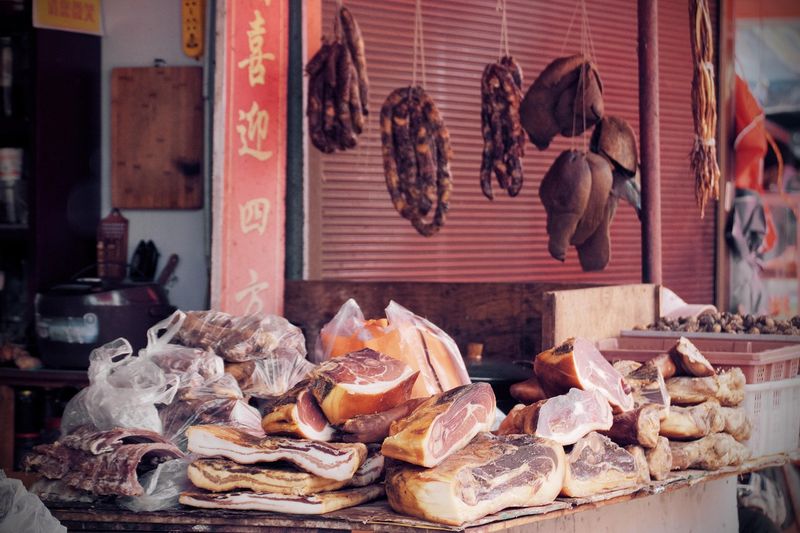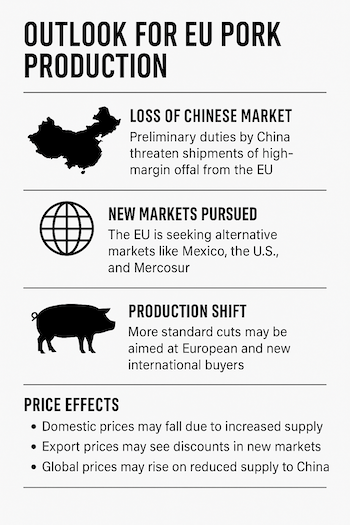
China’s New Tariffs on EU Pork
What It Means for Farmers, Exporters, and the Global Meat Market
Quick Summary
China has imposed steep temporary duties—up to 62%—on pork imports from the European Union (EU). This move strikes at a vital outlet for EU producers, especially for parts like pig ears, feet, and offal, which Chinese consumers prize but Europeans consume less. As a result, EU exporters must quickly find new markets in places like Mexico, the U.S., and South America. Domestically, Europe may see a small dip in prices, while globally, countries such as Brazil and the U.S. could benefit by filling China’s supply gap. The story isn’t just about trade spats—it’s about shifting supply chains, squeezed margins, and the reshaping of global pork flows.

Why This Matters
The EU is one of the world’s largest pork exporters, and China is its biggest buyer. When China suddenly adds duties that make EU pork much more expensive, it doesn’t just hurt European farmers and exporters—it reshuffles the global meat map. What used to go to China must now be sold somewhere else, while other suppliers rush to take Europe’s place in Asia.
What Happened: The Tariffs
On September 5, 2025, China announced preliminary anti-dumping tariffs on pork and pig by-products from the EU.
These duties range from 15.6% to 62.4%, depending on the exporter’s level of cooperation in China’s investigation.
The tariffs will be in effect from September 10, 2025, until at least December 2025, when the investigation concludes.
China says the move is about unfair trade practices. The EU, however, sees it as retaliation for Europe’s own tariffs on Chinese electric vehicles earlier this year. Whatever the politics, the economic fallout is real.
The Biggest Hit: Offal
In Europe, consumers prefer pork chops, loins, and hams. But in China, offal—pig ears, feet, snouts, and internal organs—is in high demand. These parts fetch premium prices in China, making them essential for EU processors’ profitability. Without access to this market:
Producers may have to sell offal cheaply in Europe, where demand is low.
Margins could shrink, since these exports helped balance the books for slaughterhouses.
Europe’s Response: New Markets
EU officials and exporters are working to reorient trade flows quickly:
Mexico: A new EU-Mexico trade agreement aims to reduce tariffs on European pork, making Mexico a promising alternative.
Mercosur (South America): The EU is advancing a trade pact with Argentina, Brazil, Paraguay, and Uruguay, opening the door to tariff cuts and new quotas.
United States: Though traditionally a pork exporter itself, there may be niche opportunities, especially for cuts that match U.S. consumer preferences.
Still, none of these markets can fully replace China in the short term, particularly for offal.
What It Means for Prices
In Europe
Potential downward pressure: Extra pork and offal left in Europe could push prices down slightly.
Offset by production cuts: High feed and energy costs mean some farmers may reduce herd sizes, preventing a major glut.
In Export Markets
To secure new buyers, EU exporters may have to discount prices, especially for less desirable cuts.
Margins will tighten, particularly for processors that relied heavily on China’s offal demand.
Globally
Brazil, the U.S., and Argentina are likely to step in and supply more pork to China, especially offal.
Increased competition for Chinese demand could lift prices in those exporting countries.
Global meat prices, already at record highs due to beef shortages, may rise further if pork trade disruptions spread.
Winners and Losers
Winners: Brazil, the U.S., and other suppliers that can increase pork shipments to China. UK producers may also benefit, since their offal exports to China are growing.
Losers: EU exporters, particularly those in Spain, Denmark, Germany, the Netherlands, and Belgium, which together make up the bulk of EU pork trade with China.
Neutral/uncertain: Consumers in Europe might see slightly cheaper pork, but any price relief may be offset by inflation and high production costs.
Bigger Picture: Trade Politics and the Meat Industry
This dispute isn’t just about pork—it’s part of a larger trade chess match between Europe and China. Agricultural products often get caught up in broader disputes, whether over cars, steel, or green technology. For meat professionals worldwide, the lesson is clear: market diversification is critical. Relying too heavily on one export market—no matter how lucrative—can be risky.
What to Watch Next
December 2025: China’s final decision on the duties. They could become permanent.
EU-Mercosur and EU-Mexico trade deals: Will these pass quickly enough to soften the blow?
Global price movements: If pork prices rise globally, consumers may shift further toward chicken, accelerating trends already seen in recent years.
Conclusion
China’s tariffs on EU pork are more than a temporary setback. They highlight how global politics and economics are deeply linked to what ends up on dinner plates. For European meat professionals, this is a wake-up call to diversify markets, rethink product mixes, and prepare for tighter margins. For the global industry, it’s a reminder that when one major buyer shifts direction, the ripple effects are felt worldwide.
Sources:
https://www.ft.com/content/59355df0-0c0e-4823-83e2-ad83ab0b84de
https://www.reuters.com/world/china/china-slaps-preliminary-duties-eu-pork-imports-2025-09-05/
https://www.ft.com/content/59355df0-0c0e-4823-83e2-ad83ab0b84de
https://www.eusmecentre.org.cn/chinas-anti-dumping-investigation-into-eu-pork/
https://www.foodingredientsfirst.com/news/china-eu-pork-anti-dumping-duties.html
https://ec.europa.eu/commission/presscorner/detail/en/ip_25_1644
https://www.tridge.com/news/the-new-trade-agreement-between-the-eu-and-m-hytzzh
https://www.reuters.com/business/whats-eu-mercosur-deal-why-is-it-contentious-2025-09-03/
https://www.wsj.com/livecoverage/stock-market-today-dow-sp-500-nasdaq-09-03
2025/card/eu-pushes-ahead-with-south-america-trade-deal-zDpnW8WXoSHgQpIQ0HcW
https://www.eubusiness.com/trade/eu-to-speed-ratification-of-mercosur-trade-deal/
